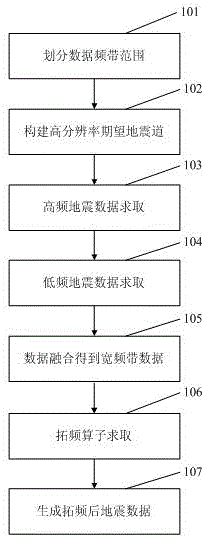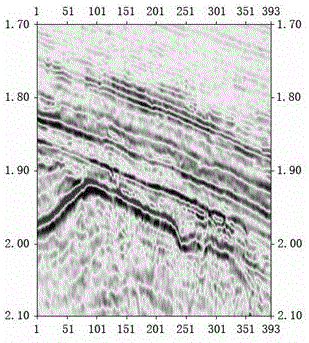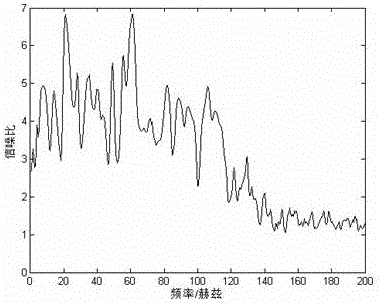Pre-stack seismic data frequency band expanding method of combining well information and horizon information
A pre-stack seismic and seismic data technology, applied in the field of pre-stack seismic data frequency band expansion, can solve the problems of low resolution and cumbersome processing methods
- Summary
- Abstract
- Description
- Claims
- Application Information
AI Technical Summary
Problems solved by technology
Method used
Image
Examples
Embodiment 1
[0041] Embodiment 1, a method for expanding frequency bands of pre-stack seismic data combining well data and horizon data includes:
[0042] Step 1: Analyze the frequency band range of seismic data, signal-to-noise ratio spectrum analysis, signal purity spectrum and frequency division profile, and divide the data frequency band range.
[0043] Step 2, the method of constructing the expected seismic trace next to the well. This method selects the broadband wavelet, and uses the convolution theory or finite difference forward modeling to combine the logging data (logging wave impedance, logging density curve) with the pre-stack time migration The wellside seismic traces are matched to construct high-resolution expected seismic traces.
[0044] Step 3. The high-frequency seismic data (the frequency band range is related to the conditions of the work area and the depth of the horizon) are obtained through the sparse reflection coefficient profile construction method. This method ...
Embodiment 2
[0048] Embodiment 2, a method for expanding frequency bands of pre-stack seismic data combining well data and horizon data, comprising the following steps:
[0049] Step 1: Analyze the signal-to-noise ratio spectrum and frequency spectrum of the seismic data, and divide the frequency band range;
[0050] Step 2: Construct high-resolution desired seismic traces;
[0051] Step 3: Obtain high-frequency seismic data;
[0052] Step 4: Obtain low-frequency seismic data;
[0053] Step 5: Fusion of high-frequency and low-frequency data, reconstruction to obtain broadband seismic data;
[0054] Step 6: Calculate the frequency extension operator, and perform frequency extension processing under the constraint of SNR spectrum to obtain broadband pre-stack seismic data.
[0055] further:
[0056] In step 1, the signal-to-noise ratio spectrum of seismic data is obtained by using the cross-correlation between seismic traces and the autocorrelation of each seismic trace, and the frequenc...
Embodiment 3
[0062] Example 3, such as figure 1 As shown, a pre-stack seismic data frequency band expansion method combining well data and horizon data includes the following steps:
[0063] In step 1, the data analysis of the work area is carried out, including the frequency band range of the seismic data in the work area, the signal-to-noise ratio spectrum analysis, the purity spectrum of the signal, and the frequency division profile, and the frequency bands of the work area data are divided into low frequency bands, transition frequency bands, dominant frequency bands, and transition frequency bands. The frequency band and the high frequency area to be improved.
[0064] In step 2, singular values are removed from the analysis of the acoustic wave and density log curves, so as to eliminate the influence of the corrected borehole diameter. In the logging data, the compressional wave velocity curve and density curve in the data are mainly used, and the time-depth relationship curve de...
PUM
 Login to View More
Login to View More Abstract
Description
Claims
Application Information
 Login to View More
Login to View More - R&D
- Intellectual Property
- Life Sciences
- Materials
- Tech Scout
- Unparalleled Data Quality
- Higher Quality Content
- 60% Fewer Hallucinations
Browse by: Latest US Patents, China's latest patents, Technical Efficacy Thesaurus, Application Domain, Technology Topic, Popular Technical Reports.
© 2025 PatSnap. All rights reserved.Legal|Privacy policy|Modern Slavery Act Transparency Statement|Sitemap|About US| Contact US: help@patsnap.com



